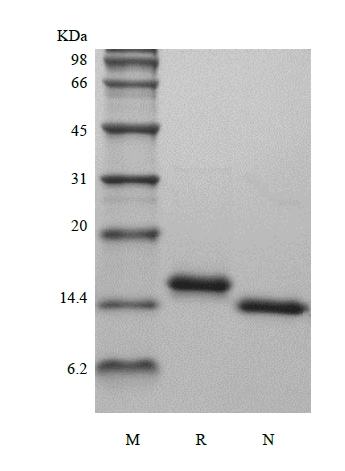| Official Full Name |
Recombinant Rat Interleukin-22 (rRtIL-22) |
| Squence |
 |
| Amino Acid Sequence |
LPINSQCKLE AANFQQPYIV NRTFMLAKEA SLADNNTDVR LIGEELFRGV KAKDQCYLMK QVLNFTLEDV LLPQSDRFQP YMQEVVPFLT KLSIHLSPCH ISGDDQNIQK NVRQLKETVQ KLGESGEIKA IGELDLLFMS LRNACV |
| Synonyms |
Cytokine Zcyto 18, TIF |
| Accession Number |
Q198B4 |
| GeneID |
|
| Summary |
IL-22 is belonging to IL-10 family of regulatory cytokines which includes IL-10, IL-19, IL-20, IL-22, IL-24 and IL-26. Members of this family share partial homology in their amino acid sequences, but they are dissimilar in their biological functions. Produced by T lymphocytes and dendritic cells, IL-10 contributes to the inflammatory response in vivo. IL-22 signals through CRF2-4 and IL-22. It along with IL-17 is rapidly produced by splenic LTi-like cells and can be also produced by Th17 cells and likely plays a role in the coordinated response of both adaptive and innate immune systems. Recombinant rat Interleukin-22 contains 146 amino acids and it has approximately 79 % and 92 % amino acid sequence identity with human and murine IL-22. |
| Source |
Escherichia coli. |
| Molecular Weight |
Approximately16.6 kDa, a single non-glycosylated polypeptide chain containing 146 amino acids. |
| Biological Activity |
Fully biologically active when compared to standard. The ED50 as determined by inducing IL-10 secretion of human COLO 205 cells is less than 0.5 ng/ml, corresponding to a specific activity of > 2.0 × 106 IU/mg. |
| Appearance |
Sterile filtered white lyophilized (freeze-dried) powder. |
| Formulation |
Lyophilized from a 0.2 um filtered concentrated solution in PBS, pH 7.4. |
| Endotoxin |
Less than 1 EU/ug of rRtIL-22 as determined by LAL method. |
| Reconstitution |
We recommend that this vial be briefly centrifuged prior to opening to bring the contents to the bottom. Reconstitute in sterile distilled water or aqueous buffer containing 0.1 % BSA to a concentration of 0.1-1.0 mg/ml. Stock solutions should be apportioned into working aliquots and stored at ≤ -20 °C. Further dilutions should be made in appropriate buffered solutions. |
| Stability and Storage |
Use a manual defrost freezer and avoid repeated freeze-thaw cycles.- 12 months from date of receipt, -20 to -70 °C as supplied.- 1 month, 2 to 8 °C under sterile conditions after reconstitution.- 3 months, -20 to -70 °C under sterile conditions after reconstitution. |
| References |
|
| SDS-PAGE |
 |
| Safety Data Sheet (SDS) Download |
Click to download |
| Technical Data Sheet (TDS) Download |
Click to download |



